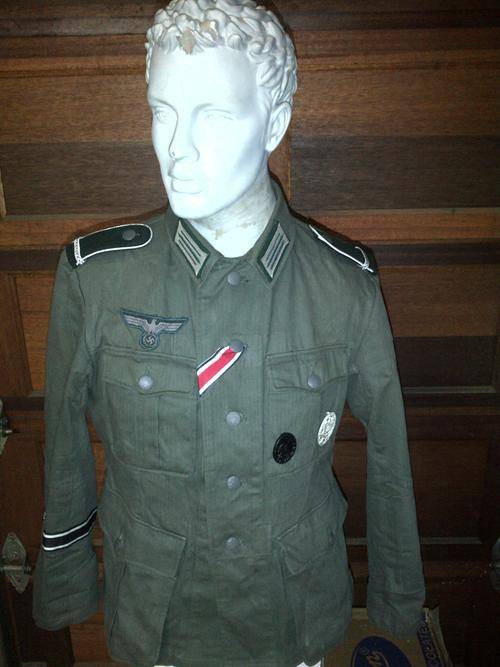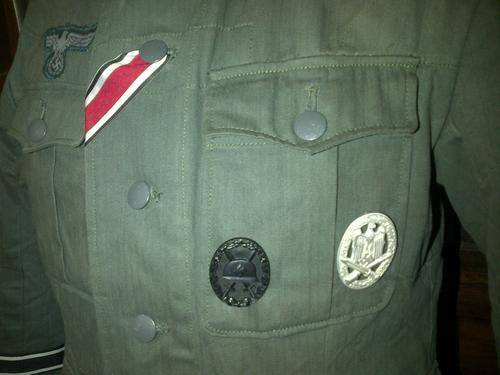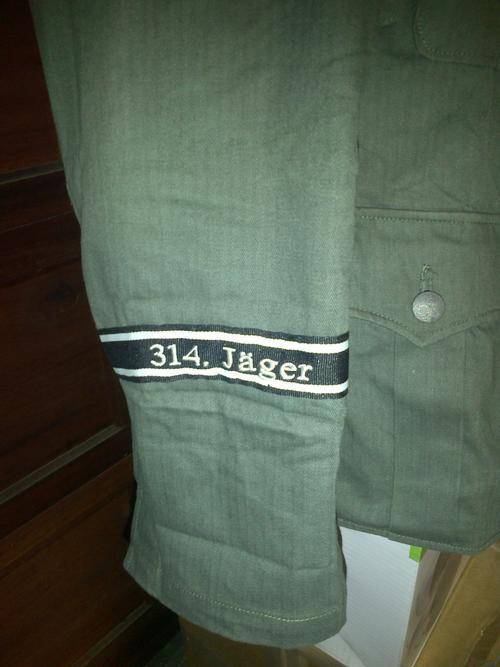
WW2 German Wehrmacht Heer Landser M40 HBT Tunic with Medals
Check my rate
| Main centres: | 1-3 business days |
| Regional areas: | 3-4 business days |
| Remote areas: | 3-5 business days |

| Main centres: | 1-3 business days |
| Regional areas: | 3-4 business days |
| Remote areas: | 3-5 business days |
You are bidding on one WW2 German Wehrmacht Heer Landser M40 HBT Tunic, with associated awards. All items in this listing are replicas. The tunic is made from HBT, and sized to fit a 40" chest. Collar is somewhat tight, but was usually worn open in combat for better ventilation.
The M40 tunic was introduced in 1940, during the second year of the war, and incorporated a number of changes from the older M36 tunic. In this case, the chief difference is the use of herringbone twill - HBT, also known as denim or drillich - for use by Wehrmacht forces in the summer, as well as in the warmer Mediterranean climate.
 The tunic bears the rank of a Private in the German Wehrmacht, with silver Anwärter rings around each shoulder board to indicate that the wearer is currently a candidate for promotion to NCO rank. The service piping (waffenfarbe) is white, indicating that the wearer belongs to an Infantry division. The collar tabs (litzen) are the early-war mounted models, and were relatively scarce after 1942. The Wehrmacht breast eagle (Reichsadler) is of the mid-war machine-embroidered type known as BEVO, and was introduced as a cost-saving measure.
The tunic bears the rank of a Private in the German Wehrmacht, with silver Anwärter rings around each shoulder board to indicate that the wearer is currently a candidate for promotion to NCO rank. The service piping (waffenfarbe) is white, indicating that the wearer belongs to an Infantry division. The collar tabs (litzen) are the early-war mounted models, and were relatively scarce after 1942. The Wehrmacht breast eagle (Reichsadler) is of the mid-war machine-embroidered type known as BEVO, and was introduced as a cost-saving measure.
 The wearer of this tunic has earned the following awards:
The wearer of this tunic has earned the following awards:
- The Iron Cross 2nd Class, as indicated by the black/white/red ribbon in the second button-hole. The EK2 medal was never worn on the uniform, with only the ribbon instead being worn in the manner showed (this prevented the medal from being damaged, or getting in the way during combat).
- The Wound Badge, Black Grade, as indicated by the black badge depicting a stahlhelm and two crossed daggers. This medal was awarded to soldiers who had been wounded in combat, and was a common sign among veteran troops.
- The General Assault Badge, Silver Grade, as indicated by the silver badge depicting a Reichsadler (Reich Eagle) clutching a hakenkreuz over a crossed bayonet and stielgranate. This medal was awarded to soldiers who had participated in at least three consecutive days of front-line combat, and was the sign of a tough fighter more often than not. The wearer of this tunic earned this award while still a member of the 314th Jäger Regiment, a non-Infantry unit.
 On the right sleeve, the tunic also carries a regimental cuff title for the 314th Jäger regiment. The Jäger units were light infantry units midway between the massive Infantry divisions and the lightly-equipped Gebirgsjäger (mountain troops) units. They relied on better speed (due to their lighter equipment) and better communication, as well as a higher percentage of automatic weapons, to gain a tactical advantage in urban and hilly/rough combat areas.
On the right sleeve, the tunic also carries a regimental cuff title for the 314th Jäger regiment. The Jäger units were light infantry units midway between the massive Infantry divisions and the lightly-equipped Gebirgsjäger (mountain troops) units. They relied on better speed (due to their lighter equipment) and better communication, as well as a higher percentage of automatic weapons, to gain a tactical advantage in urban and hilly/rough combat areas.
According to the Wehrmacht dress codes, a wearer of a cuff title had to discard his old cuff title if he moved to a new unit which had a different cuff title. However, if the wearer of the cuff title moved to a unit which did NOT have its own cuff title, the wearer was allowed to retain their old cuff title - as is the case here. It can also be commonly seen in photos of the 12th SS Panzer Division "Hitlerjugend", with many of the officers and NCO's wearing cuff titles from their old divisions.
The tunic has been aged to give it more of a 'field-worn' look, to match the combat experience of the wearer. Uniform can be hand-washed in lukewarm water and ironed on low heat if necessary. Considering how much most buyers will pay extra for a piece of equipment that looks as if it has seen combat, cleaning the tunic heavily would not be advised!